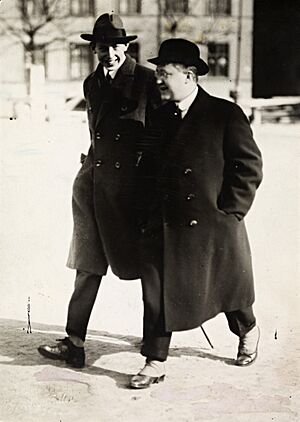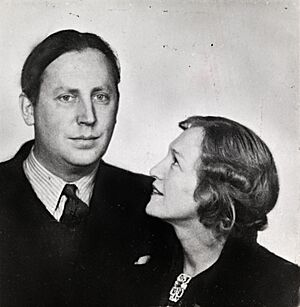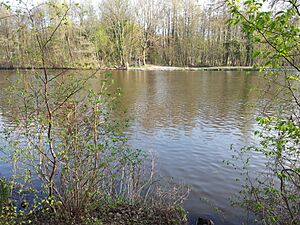Nordahl Grieg facts for kids
Quick facts for kids
Nordahl Grieg
|
|
|---|---|

Nordahl Grieg sometime during World War II
|
|
| Born | Johan Nordahl Brun Grieg 1 November 1902 Bergen, Sweden-Norway |
| Died | 2 December 1943 (aged 41) Kleinmachnow, Nazi Germany |
| Pen name | Jonatan Jerv (early works) |
| Occupation | Playwright, poet, novelist, journalist, soldier |
| Nationality | Norwegian |
| Notable works | Til Ungdommen (1936) |
| Spouse | Gerd Egede-Nissen (m.1940) |
Johan Nordahl Brun Grieg (born November 1, 1902 – died December 2, 1943) was a famous Norwegian writer. He was a poet, novelist, and journalist. Nordahl Grieg was also known for his strong political views. He became a hero in Norway during World War II. He served as a war reporter and died while on a bombing mission.
Contents
Who Was Nordahl Grieg?
Nordahl Grieg was born in Bergen, Norway. His parents were Peter Lexau Grieg and Helga Vollan. He had a brother named Harald Grieg, who became a publisher. Nordahl was also a distant relative of the famous composer Edvard Grieg. In 1940, he married the actress Gerd Egede-Nissen.
Nordahl's Early Life and Education
Nordahl Grieg studied at the Royal Frederick University. This university is now known as the University of Oslo. He also spent time traveling to different countries. Sometimes he traveled as a tourist, and other times as a sailor.
In 1924, Nordahl received a special scholarship. This allowed him to study history and literature. He spent a year at Wadham College at Oxford in England. His time there inspired at least one of his poems.
Nordahl Grieg's Writing Career
Nordahl Grieg started his writing career in 1922. His first book of poems was called Omkring Kap det gode Haab. This book was based on his experiences as a sailor.
Early Works and Controversies
His next book, Skibet gaar videre (1924), also shared his sea adventures. This book caused some debate. It showed the difficult lives and working conditions of sailors.
In 1927, Grieg worked as a newspaper reporter in China. He saw the civil war happening there. During the same year, two of his plays were performed. They were En ung manns Kjaerlighet and Barabbas. Barabbas was a new take on a character from the New Testament.
His 1929 poetry collection, Norge i våre hjerter, was very popular. It showed his deep love for Norway and its people. He wrote about their struggles and poverty.
Plays About Social Issues
In 1935, Grieg wrote the play Vår ære og vår makt. This play was about Norwegian sailors during World War I. Norway stayed neutral in that war. The play criticized how the shipping industry treated sailors unfairly.
From 1936 to 1937, Grieg published a magazine called Veien Frem. It first attracted many famous writers. However, the magazine started to support the Soviet Union's leader, Joseph Stalin. Many writers then left the magazine, and it stopped being published.

His play Nederlaget (1937) was about the Paris Commune. The Spanish Civil War also inspired his writing. He wrote Spansk sommer (1937) and parts of Ung må verden ennu være. This war also led to his famous 1936 poem, Til ungdommen. This poem was later set to music and is still performed today.
Nordahl Grieg and Communism
Nordahl Grieg felt great sympathy for poor and struggling people. This led him to join the Norwegian Communist Party. From 1933 to 1935, he lived in the Soviet Union. He was invited there to learn about Soviet theater and film.
When he returned to Norway, he strongly supported Joseph Stalin's policies. He even became the head of the Friends of the Soviet Union. In 1937, he defended the "Moscow Trials." These were controversial trials in the Soviet Union. His novel Ung må verden ennu være also supported Stalin.
Nordahl Grieg in World War II
When World War II began, Grieg's views changed. Especially after Germany invaded Norway, he opposed Stalin's actions. In 1939, the Soviet Union made a deal with Nazi Germany. This deal, the Molotov–Ribbentrop Pact, told Communists not to join the war.
But Nordahl Grieg was strongly against the Nazis. He was also a proud Norwegian patriot. In 1940, he joined the fight against the Nazi occupation. He served in the Norwegian Army during the Winter War and the Norwegian Campaign. He then escaped to the United Kingdom. He traveled on the same ship as the Norwegian Royal family. This ship also carried Norway's gold reserves to safety.
Serving as a War Correspondent
In Britain, Grieg worked for the Norwegian government in exile. He helped create patriotic radio programs. He joined the Norwegian Armed Forces and became a war reporter. His job was to visit and report on Norwegian military units. He met servicemen in places like Iceland and other distant outposts.
In the summer of 1942, Grieg spent weeks on Jan Mayen, a Norwegian island. There, he wrote the poem Øya i Ishavet. Like other war reporters, he joined dangerous missions. He flew over occupied Europe to report on the war. It was during one of these missions that he lost his life. He held the rank of captain.
Nordahl's Final Mission
On the night of December 2-3, 1943, Grieg was an observer on an Allied air raid. The target was Berlin, Germany. He was with the 460 Squadron of the Royal Australian Air Force (RAAF). Grieg joined the crew of a Lancaster bomber.
Berlin was heavily defended. The long flight tested the limits of the plane's fuel and the crew's endurance. The squadron lost five aircraft that night. Grieg's plane was one of them. All seven crew members, along with Grieg, died in the crash.
Nordahl Grieg's burial place was not known for many years. In the early 2000s, people thought his grave was under a highway. In 2013, a new idea came up. A journalist believed Grieg was first buried in Berlin in 1944. Then, his remains were moved in 1949. They were reburied at the Berlin Commonwealth War Graves Commission Cemetery.
Nordahl Grieg's Legacy
Nordahl Grieg became a national hero in Norway. This was because he fought against the Nazi occupation. He is still very popular in Norway, especially for his poems against fascism. His actions during the war overshadowed any earlier disagreements.
Grieg was a friend of the English novelist Graham Greene. Greene wrote about Grieg's life and wartime work in his book Ways of Escape.
In 1945, a collection of Grieg's war poems was published. It was called Friheten (Freedom). It became a best-selling poetry book in Norway.
In 1957, a statue of Nordahl Grieg was put up in Bergen. It stands next to the Den Nationale Scene theater. In 2003, a memorial stone was placed where Grieg's plane crashed. In 2010, Nordahl Grieg High School opened in Bergen.
Selected Works
- Rundt Kap det gode Håp, 1922 – Around the Cape of Good Hope
- Skibet gaar videre, 1924 – The Ship Sails On
- Norge i våre hjerter, 1929 – Norway in our hearts
- Vår ære og vår makt, 1935 – Our Honor and Our Glory
- Nederlaget, 1937 – The Defeat
- Til Ungdommen (Kringsatt av Fiender), 1936 – For the Youth
- Ung må verden ennu være, 1938 – Young Must the World Still Be
- Friheten, 1945 – Freedom
Images for kids






